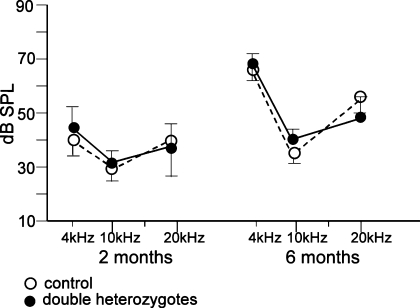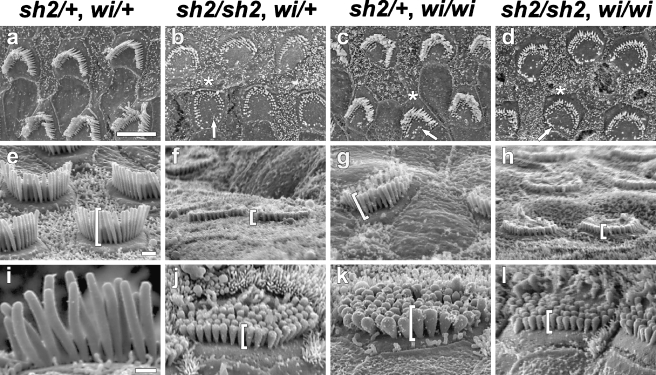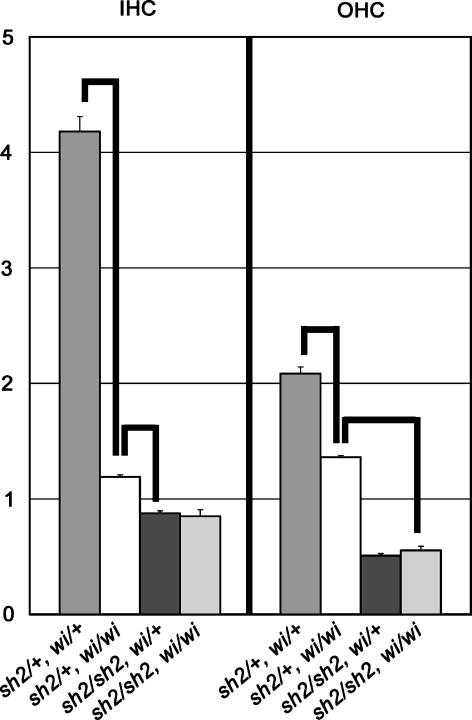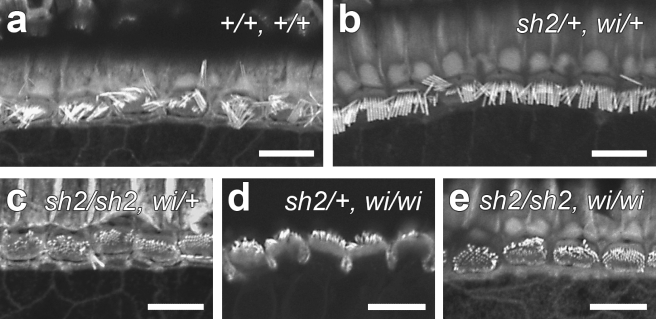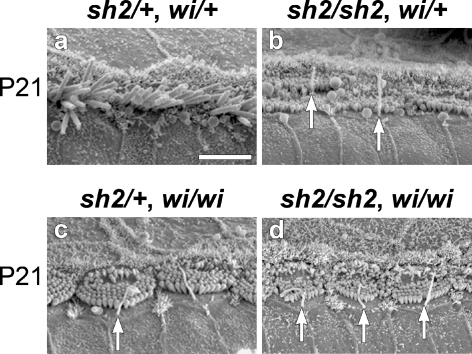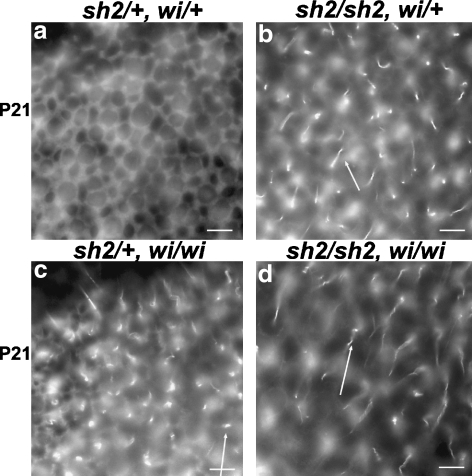Abstract
MYOSIN XV is a motor protein that interacts with the PDZ domain-containing protein WHIRLIN and transports WHIRLIN to the tips of the stereocilia. Shaker 2 (sh2) mice have a mutation in the motor domain of MYOSIN XV and exhibit congenital deafness and circling behavior, probably because of abnormally short stereocilia. Whirler (wi) mice have a similar phenotype caused by a deletion in the third PDZ domain of WHIRLIN. We compared the morphology of Whrnwi/wi and Myo15sh2/sh2 sensory hair cells and found that Myo15sh2/sh2 have more frequent pathology at the base of inner hair cells than Whrnwi/wi, and shorter outer hair cell stereocilia. Considering the functional and morphologic similarities in the phenotypes caused by mutations in Myo15 and Whrn, and the physical interaction between their encoded proteins, we used a genetic approach to test for functional overlap. Double heterozygotes (Myo15sh2/+, Whrnwi/+) have normal hearing and no increase in hearing loss compared to normal littermates. Single and double mutants (Myo15sh2/sh2, Whrnwi/wi) exhibit abnormal persistence of kinocilia and microvilli, and develop abnormal cytoskeletal architecture. Double mutants are also similar to the single mutants in viability, circling behavior, and lack of a Preyer reflex. The morphology of cochlear hair cell stereocilia in double mutants reflects a dominance of the more severe Myo15sh2/sh2 phenotype over the Whrnwi/wi phenotype. This suggests that MYOSIN XV may interact with other proteins besides WHIRLIN that are important for hair cell maturation.
Keywords: genetics, mouse model, age-related deafness, gene expression, kinocilium
INTRODUCTION
The mammalian inner ear has specialized hair cells that detect sound and movement of the head. The stereocilia on the apical surface of these cells constitute a mechanosensitive organelle with precisely organized actin-filled projections (Moran et al. 1981). These projections develop from microvilli on the hair cell surface. Cochlear hair cells also have a kinocilium, which is a transient organelle that regresses around postnatal day 8 (P8) in mice, and eventually disappears at P12, whereas it is a permanent organelle of the vestibular hair cells (Kikuchi and Hilding 1965; Kimura 1966). Alterations in morphogenesis of the stereocilia can result in hearing loss, balance defects, or both. This maturation involves patterning, increased girth, elongation, and cohesion. MYOSIN XV and the PDZ domain-containing protein WHIRLIN are components of the molecular complex that underlies the elongation process (Delprat et al. 2005; Belyantseva et al. 2005; Kikkawa et al. 2005). Dysfunction of either MYOSIN XV or WHIRLIN causes deafness in humans and mice (Probst et al. 1998; Liang et al. 1999; Mburu et al. 2003). Two recessive deaf mouse mutants, shaker 2 (Myo15sh2/sh2) and whirler (Whrnwi/wi), exhibit abnormally short stereocilia (Probst et al. 1998; Holme et al. 2002), although no direct comparisons of the length of stereocilia have been reported. MYOSIN XV is normally found at the tips of the stereocilia, from embryonic day 18.5 (E18.5) through adulthood, indicating that MYOSIN XV might be important for maintenance of hair cell viability. Although WHIRLIN is also normally localized to the tips of the stereocilia, its expression is dynamic during growth of the sterocilia, exhibiting early appearance of the protein product in inner hair cells (IHCs) that fades out at P11, and later appearance in the outer hair cells (OHC) at P14. This pattern is consistent with the earlier maturation of IHC stereocilia relative to those of OHC (Kikkawa et al. 2005). The colocalization of MYOSIN XV and WHIRLIN in the tips of the stereocilia, and the functional interaction between the MYOSIN XV tail and the PDZ domains of WHIRLIN, suggest that MYOSIN XV is a vehicle for transporting and localizing WHIRLIN to the tips of the stereocilia (Delprat et al. 2005; Belyantseva et al. 2005; Kikkawa et al. 2005).
Previous studies have shown evidence for digenic inheritance of hearing deficiency. Mutations in cadherin 23 (Cdh23) and protocadherin 15 (Pcdh15) mutations are autosomal recessive (Zheng et al. 2005). Humans and mice that are heterozygous for mutations in both of these genes exhibit deafness, whereas single heterozygotes lack this pathology. Intriguingly, Cdh23 and Pcdh15, like Myo15 and Whrn, play essential roles in maintaining the hair cell bundle of stereocilia. Examples of digenic diseases have also been described for retinitis pigmentosa, glaucoma, and diabetes (Goldberg and Molday 1996; Vincent et al. 2002; Savage et al. 2002). Many of these cases of digenic inheritance involve proteins that interact or function in the same pathway (Rudnicki et al. 1993; Goldberg and Molday 1996). Given the functional and morphologic similarities of the cochlear phenotypes caused by mutations in Myo15 and Whrn genes, we tested for a potential digenic interaction (or functional overlap) between Myo15 and Whrn using a classical genetic approach.
MATERIALS AND METHODS
Mice
All mice were obtained from the Jackson Laboratory (Bar Harbor, ME, USA). All procedures were approved by the University of Michigan Committee on Use and Care of Animals. In general, the Whrnwi/wi females were bred to Myo15sh2/sh2 males, and F1 progeny mice from this cross were intercrossed (F1 × F1), and F2 progeny were examined. In some cases double heterozygotes (F1) were replaced with animals mutant at one locus and heterozygous at the other to enhance the frequency of the double mutant genotype above 1/16 predicted for a double heterozygote intercross. At least three animals of each genotype were analyzed at each age (P0–P1, P5–P6, P10, P12, P17, P21, P30, P35, P49, and P180). P0 is designated as the day of birth.
Assessment of hearing by auditory brainstem response
Auditory brainstem responses (ABRs) were conducted as previously described (Beyer et al. 2000). Three to four animals in each category were tested at three frequencies: 4, 10, and 20 kHz.
Apical hair cell morphology assessed by scanning electron microscopy
For scanning electron microscopy (SEM) analysis, animals were killed and temporal bones were removed and fixed with 2% glutaraldehyde in 0.15 M of cacodylate buffer. Cochleae were processed using the OTOTO method, which involves immersing the tissues alternately in thiocarbohydrazide and osmium tetroxide (Osborne and Comis 1991). They were critical point dried and mounted on stubs using colloidal silver paste. Samples were examined with an Amray 1000B SEM. At least three animals of each genotype and age (P17, P21, and p35) were examined.
Phalloidin epifluorescence
For phalloidin analysis, animals were killed and the temporal bones removed. The temporal bones were immersed in 4% paraformaldehyde in phosphate buffer (0.15 M, pH 7.35). Under stereoscopic magnification, the round and oval windows were opened, and the bone from the apical tip of the cochleae was removed to allow fixative to flow throughout the tissue. Two hours later, the otic capsule was trimmed to reveal the modiolus and the organ of Corti. The entire apical turn and several fragments of the basal turn were separated from the modiolus and from the lateral wall tissues. Samples were permeabilized in Triton X-100 (0.3%, 5 min) and incubated with phalloidin 488 (Molecular Probes, Eugene, OR, USA) 1:200 in phosphate-buffered saline for 30 min. After thorough rinsing, the tissues were mounted on glass slides with CrystalMount (Biomeda, Foster City, CA, USA). Tissues were analyzed and photographed on a Leica DMRB epifluorescence microscope using ×40 oil and ×100 oil objectives and a standard fluorescein isothiocyanate (FITC) filter.
Confocal
Confocal microscopy was used to study the differences in stereocilia length between genotypes. Whole mounts of the midcochlear turn were stained with phalloidin as described, then analyzed by confocal microscopy with a Zeiss laser scanning microscope LSM-510. To obtain measurements of stereocilia, Z-series images of 0.5 μm were taken from the apical portion of the sensory epithelium, spanning the entire stereociliar length.
Genotyping
All F1 and F2 animals were genotyped by polymerase chain reaction (PCR). Genotyping for the Myo15sh2 and Whrnwi mutations was as previously described (Probst et al. 1998; Holme et al. 2002). Additional primers were designed to distinguish between the Whrn wild type (+/+) and the heterozygote animals, which are 5′-CCGGCATCCACGCCACTGTCCTC-3′ and 5′-AGCCGGCTCCCAGGTGACCCTGA-3′. These primers do not amplify the wild-type allele, but they do amplify the heterozygote allele as a ∼2-kb band. PCR parameters are 92°C for 2 min; 4 cycles at 94°C for 5 s, 72°C for 2 min; 4 cycles at 94°C for 5 s, 70°C for 2 min; and 39 cycles at 94°C 5 s, 68°C for 2 min.
Statistical analysis of stereocilium length
For IHCs, stereocilium length was measured in 6–13 cells per animal, 3 animals per genotype. On each cell, 3–10 stereocilia in the outer (tallest) row were measured (±0.08 μm) to establish the range of stereocilium lengths for that cell. In 85% of cells, the observed range of lengths was less than 0.16 μm, which was less than one fifth of the smallest observed midpoint values. The midpoint values were then used to compute the mean stereocilium length for the animal. The animal means were analyzed by ANOVA to test whether stereocilium length differed among genotypes. Subsequently, genotype means were computed from animal means, order by magnitude, and t tests were performed on successively large differences between adjacent pairs to identify which genotypes differ in mean stereocilium length, with appropriate Bonferroni adjustment of the criterion for statistical significance to maintain a table-wide α = 0.05. Genotype means are reported with the standard error of the mean ( ) because this quantity reflects the criterion used in the t test to determine whether the means are different.
) because this quantity reflects the criterion used in the t test to determine whether the means are different.
For OHCs, 11–16 cells per animal were measured (±0.125 μm). In two third of the cells, the range was less than 0.125 μm, or about one fourth of the smallest midpoint values. Differences between genotypes were evaluated by the same procedures used for IHCs.
RESULTS
Hearing is unaffected by partial deficiency of Myo15 and Whrn
Mice carrying Myo15sh2 and Whrnwi mutant alleles were crossed to generate double heterozygotes (Myo15sh2/+, Whrnwi/+). These progeny were intercrossed to generate double mutants, single mutants, and littermate controls. F1 double heterozygote animals appeared normal, did not circle, and showed a normal Preyer reflex. Double heterozygotes and single heterozygotes were subjected to ABR testing at 2 and 6 months of age. Testing was designed to determine if heterozygosity for both of these two recessive deafness genes is a risk factor for initial or age-related hearing loss. At 2 months of age, doubly heterozygous Myo15sh2/+, Whrnwi/+ mice had ABR thresholds indistinguishable to those of single heterozygote control mice (Fig. 1). At 6 months of age, Myo15, Whrn double heterozygotes exhibited shifts in ABR thresholds of about 22 and 10 dB at 4 and 20 kHz frequencies, respectively. Age-related hearing loss in doubly heterozygous mice was not greater than in animals heterozygous for mutation in only one of the genes. Morphological analyses with SEM supported the physiological results of ABR studies that indicated no difference between double heterozygotes and normal mice.
FIG. 1.
Myo15sh2 and Whrnwi double heterozygotes hear as well as single heterozygotes. ABR tests were performed on 2- and 6-month-old doubly heterozygous mice (filled circles) and single heterozygote controls (open circles) at frequencies of 4, 10, and 20 kHz. The sound pressure level thresholds, measured in decibels (dB), are indistinguishable between double heterozygotes and controls.
The inner ear morphology of double mutants reflects dominance of Myo15sh2/sh2 phenotype over the Whrnwi/wi phenotype
Doubly homozygous pups (Myo15sh2/sh2, Whrnwi/wi) were viable and recovered at expected frequencies. Double mutants, however, circled and had no Preyer reflex. Myo15 and Whrn are both expressed in the endocrine glands (Karolyi et al. 2003; Liang et al. 1999). No obvious associated defects were observed for the corresponding double mutants in the function of these organs.
The inner ears of double heterozygotes, single and double homozygotes littermates were examined by SEM and light microscopy at P21 (Fig. 2). SEM of the midturn of the cochlea revealed normal OHC morphology at the apical surface of double heterozygotes, and the presence of all defined cell types of the inner ear sensory epithelium in double mutant mice. OHC degeneration is apparent in Myo15sh2/sh2 single mutant and in double mutant mice by P21 in the basal and midturns of the cochlea, whereas degeneration in Whrnwi/wi single mutants is restricted to the basal cochlear turn. Similar results were obtained in younger and older mice (P17 and P35 data not shown).
FIG. 2.
Double mutants and sh2 mutants have shorter stereocilia than wi mutants. SEM was used to visualize the apical surface of cochlear hair cells in the mid turn region in mice at age P21. OHC stereocilia were analyzed in cochlear whole mounts from double heterozygotes (a), both single mutants, Myo15sh2/sh2 (b) and Whrnwi/wi (c), and Myo15sh2/sh2, Whrnwi/wi double mutants (d). The stereocilia on OHCs of double heterozygotes are indistinguishable from those of wild-type mice. OHC stereocilia in the Myo15 mutant are extremely short with abnormally persistent microvilli (arrows). Some stereocilia are arranged in a U shape (asterisk) instead of the normal V shape. The OHC stereocilia of Whrn mutants are shorter than normal, and there are persistent microvilli. Some cells have stereocilia arranged in an abnormal U shape. Myo15, Whrn double mutants have an OHC stereocilia phenotype that looks like the Myo15 single mutant. Scale bars: a–d 5 μm, e–h 1 μm, i–l 1 μm. The length of the OHC stereocilia of double heterozygotes (e) is longer than single mutants of Myo15 (f) or Myo15, Whrn double mutants (h), but subtly longer than Whrn single mutants (g). Scale bars 1 μm. The lengths of the IHC stereocilia are obviously normal in double heterozygotes and obviously longer (i) than in single mutants for Myo15 (j) or Whrn (k), or for double mutants (l), which were extremely short. Scale bars 1 μm.
The Myo15 mutant cochlea showed extremely short stereocilia on both IHCs and OHCs and persistence of transient microvilli on the apical cell surface (Fig. 2a–d), as reported previously (Probst et al. 1998; Anderson et al. 2000). Some of the OHC stereocilia in Myo15 mutants are arranged in a rounded “U” shape instead of the normal “V” or “W” shape seen in the OHC stereocilia of the double heterozygotes and other normal mice. Many pathological landmarks seen by SEM analysis in the OHCs of Myo15 and Whrn single mutants are also evident in the double mutants, such as excess microvilli, U-shaped organization of stereocilia, and shorter than normal stereocilia. However, the Whrn mutant OHC stereocilia seemed intermediate in length to normal and Myo15 mutants. In addition, the length of stereocilia on IHC of wild-type mice appeared longer than stereocilia in Myo15 or Whrn single mutants. To quantify this perception, SEM specimens were photographed at the midturn of the cochlea and stereocilia were measured (Fig. 2e–l). Specimens were oriented so that stereocilia were as close to parallel with the screen as possible and the entire vertical length of the stereocilia could be visualized. Significant differences among genotypes in mean stereocilium length were found for both IHCs (F = 493.1, df = 3.8, p < 0.001) and OHCs (F = 424.9, df = 3.8, p < 0.001). As Figure 3 shows, mean stereocilium length of IHCs was longest in the wild type (4.18 ± 0.13, n = 3) and much shorter in Whrnwi/wi (1.19 ± 0.02, n = 3) and Myo15sh2/sh2 (0.88 ± 0.02, n = 3). The mean of Myo15sh2/sh2, Whrnwi/wi (0.85 ± 0.06, n = 3) was nearly identical to Myo15sh2/sh2, and not significantly different from it (p = 0.695). The larger differences between Myo15sh2/sh2 and Whrnwi/wi and between Whrnwi/wi and wild type are both significant (p < 0.001). Mean stereocilium length of OHCs was also longest in the wild type (2.08 ± 0.06, n = 3) and shorter in Myo15sh2/sh2 (0.51 ± 0.02, n = 3) than in Whrnwi/wi (1.36 ± 0.02, n = 3). The mean was slightly greater in Myo15sh2/sh2, Whrnwi/wi (0.55 ± 0.04, n = 3) than in Myo15sh2/sh2, but the difference was not significant (p = 0.353). The larger differences between wild type and Whrnwi/wi (p = 0.007) and between Whrnwi/wi and Myo15sh2/sh2, Whrnwi/wi (p < 0.001) were significant.
FIG. 3.
Quantification of mean stereocilia length confirms differences in stereociliar length. The length of the stereocilia was measured in micrometers from SEM photographs of IHC and OHC for the four genotype classes. Means ± SE of the mean of stereocilia length are shown for IHCs and OHCs of each genotype. Brackets indicate consecutive means shown to be significantly different by t test, after Bonferroni adjustment for multiple tests.
The stereocilia of animals of each genotype was also examined by confocal microscopy. Wild type and double heterozygotes have similar stereocilia length (Fig. 4a, b). The Z-series images confirm differences in stereocilia length between double heterozygotes, single mutants, and double mutants, consistent with quantitative analysis of SEM images.
FIG. 4.
Differences in stereocilia lengths are apparent by confocal microscopy of the actin cytoskeleton. Confocal images of phalloidin labeled organ of Corti show that stereocilia of inner hairs cells are long in wild types (a) and double heterozygotes (b) and distinctly shorter in mutants (c–e). Scale bars 10 μm.
The kinocilium normally disappears by P12 (Kikuchi and Hilding 1965; Kimura 1966). However, we observed persistence of kinocilia in IHCs at P16–P17 in both single mutants and double mutants, relative to double heterozygotes at the same ages (data not shown). All single mutant littermates exhibited persistent kinocilia in the majority of IHCs of the apical turn (70% of the IHCs), a substantial number of IHCs in the midturn (30% of the cells), and negligible (0.02%) IHCs in the basal turn of the cochlea. At P21, somewhat fewer persistent kinocilia were evident in IHC of mutants (Fig. 5). At this time kinocilia were noted in 60% of the IHC within the apical turn and 20% of IHC in the midturn. At P35 there was even less persistence of the kinocilia, and regression was apparently in progress in some of the remaining kinocilia (data not shown). This phenomenon was less obvious in OHC than IHC. At P16–P17, very few kinocilia were observed in the OHCs of the apical turn of the Myo15sh2/sh2 and Whrnwi/wi single mutants or double mutants (0.02% of the cells) (data not shown).
FIG. 5.
Kinocilium regression is impaired in Myo15 and Whrn mutants. SEM analysis of IHCs in the apical turn of cochlea revealed abnormalities in apical surface morphology of mutants relative to controls. Cochlear whole mounts from P21 animals revealed abnormal persistence of kinocilia (arrows) in IHCs of single mutants of Myo15 (b) and Whrn (c), and Myo15, Whrn double mutants (d), relative to double heterozygotes in which the kinocilia have regressed (a). Scale bars 5 μm.
The cytocaud, an actin rich pathological structure, appears in the hair cells of single and double mutants
Epifluorescence examination of phalloidin/FITC-stained whole mounts of the organ of Corti revealed normal organization of cytoskeletal actin in 21-day-old double heterozygote mice (Fig. 6a). The organization at the reticular lamina (the luminal surface of the auditory epithelium) and the cuticular plate of the IHC appeared normal. In sh2/sh2 animals of a similar age, at a focal plane just beneath the reticular lamina, an abnormally thick actin bundle was evident (Fig. 6b). The bundle extended from each IHC toward the modiolar axis of the cochlea. This pathological structure has been previously described to contain cytoplasm and organelles, and has been termed a cytocaud (Beyer et al. 2000; Probst et al. 1998). Cytocauds were present at P10 in nearly every IHC of Myo15sh2/sh2 mutants. Cytocauds have not previously been reported for Whrnwi/wi mutants. We observed approximately one cytocaud in every 25–30 IHC of Whrnwi/wi mutants examined at P10, which is significantly fewer than in sh2 mice (Fig. 6c). Cytocauds are also evident in the IHCs of double mutants, with a frequency similar to Myo15sh2/sh2 mutants (Fig. 6d).
FIG. 6.
Cytocaud pathology is more severe and appears earlier in mutants with the shortest stereocilia. Epifluorescence images of phalloidin-labeled whole mounts of the organ of Corti of P21 control mice (a), single mutants of Myo15 (b) and Whrn (c), and Myo15, Whrn double mutants (d) reveal cytoskeletal actin organization abnormalities in mutants relative to controls (arrows). At the focal plane near the base of the cuticular plate, an abnormal actin-positive stain, known as a cytocaud, is detected in the IHCs of single mutants of Myo15 (b) and Whrn (c), and Myo15, Whrn double mutants (d).
Analysis of the vestibular sensory epithelium (ampulla, saccula, and utricule) revealed that the actin core of the cytocaud is apparent in most vestibular hair cells of Myo15sh2/sh2 and Whrnwi/wi single mutants and double mutants at birth (Fig. 7). There does not appear to be any difference in frequency of cytocauds in vestibular hair cells of single and double mutants, in contrast to the reduced frequency observed in Whrnwi/wi IHC in the organ of Corti.
FIG. 7.
Vestibular hair cells of Myo15 and Whrn single and double mutants exhibit cytocaud pathology at birth. Epifluorescence images of whole mounts of the ampulla of P21 control mice (a), single mutants of Myo15 (b) and Whrn (c), and Myo15, Whrn double mutants (d) labeled with phalloidin. At the focal plane just beneath the cuticular plate, an actin-positive stain is detected in most of the vestibular hair cells of Myo15 (b) and Whrn (c) single mutants and Myo15, Whrn (d) double mutants (arrows), but not in control mice.
DISCUSSION
MYOSIN XV contributes specifically to the differential elongation of the stereocilia by increasing the delivery of essential elements, like WHIRLIN and probably other cargoes, to the tips of the stereocilia. The fact that MYOSIN XV expression is maintained after the elongation process is completed while WHIRLIN expression wanes suggests that MYOSIN XV might be playing a different role than WHIRLIN in the long-term maintenance of hair cell through its interaction with different proteins. This theory is supported by the presence of additional predicted interaction domains in the tail encoded by Myo15 and by the more severe phenotype of shaker 2 (sh2) sensory hair cells compared to those of whirler (wi) mutants. Both IHC and OHC stereocilia in Myo15 mutants are shorter than those in Whrn mutants, and the frequency of cytocaud pathology is higher in the IHC of Myo15 mutants than in Whrn mutants. The Myo15sh2/sh2, Whrnwi/wi double mutants have a phenotype similar to that of Myo15 single mutant. Taking all of the pathologies together, Whrn mutant hair cells are less affected than those of Myo15 mutants and double mutants. This suggests that MYOSIN XV has a greater effect on IHC and OHC stereocilia elongation than WHIRLIN.
MYOSIN XV is necessary for transportation of WHIRLIN to the tips of the stereocilia, and the two proteins have been shown to interact physically (Belyantseva et al. 2005). Adult double heterozygotes, Myo15sh2/+, Whrnwi/+, exhibited normal ABR thresholds and normal vestibular function. There was no obvious difference in the susceptibility to age-related hearing loss in double heterozygotes compared to the single heterozygotes. Thus, 50% of the normal level of MYOSIN XV and WHIRLIN is sufficient for normal hair bundle formation, maintenance, and function. This contrasts with other genes encoding proteins that interact in which decreased dosage of both genes causes significant abnormalities (Zheng et al. 2005; Goldberg and Molday 1996). For example, Cdh23 and Pcdh15 double heterozygotes are deaf by 5 months and have abnormal stereocilia, whereas single heterozygotes are unaffected (Zheng et al. 2005).
The kinocilia and microvilli in hair cells of the organ of Corti persist longer than normal in the Myo15 and Whrn single and double mutants. The persistence of these structures may result from roles for the Myo15 and Whrn genes in general cellular maturation. Consistent with this idea, the kinocilia persist more in the IHCs than the OHCs of the mutants, and the apical pole of the IHCs normally reaches adult-like morphology more slowly than that of the OHCs (Anniko 1983). Differences in kinocilium development might contribute to the rounded U-shaped pattern of stereocilia in the mutants, instead of the normal V or W shape. In contrast to MYOSIN XV, MYOSIN VII, which is known to interact with WHIRLIN, is expressed in the kinocilium, but additional studies will be necessary to determine whether WHIRLIN isoforms localize there as well (Delprat et al. 2005; Wolfrum et al. 1998). This potential interaction raises the possibility of cross talk between the different motors and cargoes during the development of the inner ear hair cells.
Some, but not all, deaf animal models exhibit pathological actin-rich cytoplasmic extensions from the basal surface of IHC and/or vestibular hair cells, known as cytocauds (Sobin et al. 1982; Sobin and Flock 1983; Beyer et al. 2000; Sobin and Flock 1981; Ernstson et al. 1969). We describe for the first time the presence of cytocauds in Whrn mutants. The frequency of these cytocauds, however, is lower than that seen in Myo15 mutants or double mutants. The basis for the pathology is unknown, but it is intriguing that cytocaud-containing cells are predominantly innervated by afferent neurons and have higher rates of actin turnover and higher expression level of MYOSIN XV than the unaffected OHCs (Schneider et al. 2002, Rzadzinska et al. 2004; Sekerková et al. 2006). By analogy to actin assembly in yeast, the cytocaud may result from inability to nucleate and orient actin monomers in Whrn and Myo15 mutants (Evangelista et al. 2003; Kamasaki et al. 2005; Schneider et al. 2002).
We did not detect any genetic interaction between the Myo15 and Whrn genes in double heterozygotes and double mutants. In an extreme case, overlapping functions could result in a much more severe phenotype in the double mutant, potentially causing premature loss of hair cells or related structures, or even effects in other tissues. Despite coexpression of Whrn and Myo15 in endocrine tissues, no endocrine phenotypes were manifested. Intriguingly, there is no evidence for novel phenotypes arising from double heterozygotes or double homozygotes of Myo15 mutants and mutants in other motor myosin genes, including Myo7a4626SB/4626SB or Myo6sv/sv, or in the unrelated gene, Grxcr1pi/pi (Karolyi et al. 2003). In each of those cases the stereocilia of double mutants exhibited additivity of the single mutant phenotype. The reason why so many different molecular motors are required is not clear, nor is the full panoply of proteins that interact with each motor well defined. The roles of MYOSIN XV and WHIRLIN in development and regulation of normal cytoskeletal morphology may be advanced through the identification of additional protein partners.
Acknowledgments
We thank Gary Dootz for technical help and Karen Friderici, Shannon Davis, Mary Anne Potok, and Tzywen Gong for critical reading of the manuscript. This work was funded by National Organization for Hearing Research Foundation (M. M.) and by National Institutes of Health grants DC05188 (D. F. D.), DC02982 (D. F. D.), DC05401 (Y. R.), and DC05053 (S. A. C.).
References
- Anderson DW, Probst FJ, Belyantseva IA, Fridell RA, Beyer L, Martin DM, Wu D, Kachar B, Friedman TB, Raphael Y, Camper SA. The motor and tail regions of myosin XV are critical for development and function of the auditory and vestibular systems. Hum. Mol. Genet. 9:1729–1738, 2000. [DOI] [PubMed]
- Anniko M. Postnatal maturation of cochlear sensory hairs in the mouse. Anat. Embryol. (Berl) 166(3):355–368, 1983. [DOI] [PubMed]
- Belyantseva IA, Boger ET, Naz S, Frolenkov GI, Sellers JR, Ahmed ZM, Griffith AJ, Friedman TB. Myosin-XVa is required for tip localization of whirlin and differential elongation of hair-cell stereocilia. Nat. Cell Biol. 7(2):148–56, 2005. [DOI] [PubMed]
- Beyer LA, Odeh H, Probst FJ, Lambert EH, Dolan DF, Camper SA, Kohrman DC, Raphael Y. Hair cells in the inner ear of the pirouette and shaker 2 mutant mice. J. Neurocytol. 29:227–239, 2000. [DOI] [PubMed]
- Delprat B, Michel V, Goodyear R, Yamasaki Y, Michalski N, El-Amraoui A, Perfettini I, Legrain P, Richardson G, Hardelin JP, Petit C. Myosin XVa and whirlin, two deafness gene products required for hair bundle growth, are located at the stereocilia tips and interact directly. Hum. Mol. Genet. 14(3):401–410, 2005. [DOI] [PubMed]
- Ernstson, S., Lundquist, P. G., Wedenberg, E., Wersall, J. Morphologic changes in vestibular hair cells in a strain of the waltzing guinea pig. Acta Otolaryngol. 67:521–534, 1969. [DOI] [PubMed]
- Evangelista M, Zigmond S, Boone C. Formins: signaling effectors for assembly and polarization of actin filaments. J. Cell Sci. 116(Pt 13):2603–2611, 2003. [DOI] [PubMed]
- Goldberg AF, Molday RS. Defective subunit assembly underlies a digenic form of retinitis pigmentosa linked to mutations in peripherin/rds and rom-1. Proc. Natl. Acad. Sci. U S A 93(24):13726–13730, 1996. [DOI] [PMC free article] [PubMed]
- Holme RH, Kiernan BW, Brown SDM, Steel KP. Elongation of hair cell stereocilia is defective in the mouse mutant whirler. J. Comp. Neurol. 450:94–102, 2002. [DOI] [PubMed]
- Kamasaki T, Arai R, Osumi M, Mabuchi I. Directionality of F-actin cables changes during the fission yeast cell cycle. Nat. Cell Biol. 7:916–917, 2005. [DOI] [PubMed]
- Karolyi IJ, Probst FJ, Beyer L, Odeh H, Dootz G, Cha KB, Martin DM, Avraham KB, Kohrman D, Dolan DF, Raphael Y, Camper SA. Myo15 function is distinct from Myo6, Myo7a and pirouette genes in development of cochlear stereocilia. Hum. Mol. Genet. 12(21):2797–2805, 2003. [DOI] [PubMed]
- Kikkawa Y, Mburu P, Morse S, Kominami R, Townsend S, Brown SD. Mutant analysis reveals whirlin as a dynamic organizer in the growing hair cell stereocilium. Hum. Mol. Genet. 14(3):391–400, 2005. [DOI] [PubMed]
- Kikuchi K, Hilding D. The development of the organ of Corti in the mouse. Acta Otolaryngol. 60:207–222, 1965. [DOI] [PubMed]
- Kimura RS. Hairs of the cochlear sensory cells and their attachment to the tectorial membrane. Acta Otolaryngol. 61:55–72, 1966. [DOI] [PubMed]
- Liang Y, Wang A, Belyantseva IA, Anderson DW, Probst FJ, Barber TD, Miller W, Touchman JW, Jin L, Sullivan SL, Sellers JR, Camper SA, Lloyd RV, Kachar B, Friedman TB, Fridell RA. Characterization of the human and mouse unconventional myosin XV genes responsible for hereditary deafness DFNB3 and shaker 2. Genomics 61(3):243–258, 1999. [DOI] [PubMed]
- Mburu P, Mustapha M, Varela A, Weil D, El-Amraoui A, Holme RH, Rump A, Hardisty RE, Blanchard S, Coimbra RS, Perfettini I, Parkinson N, Mallon AM, Glenister P, Rogers MJ, Paige AJ, Moir L, Clay J, Rosenthal A, Liu XZ, Blanco G, Steel KP, Petit C, Brown SD. Defects in whirlin, a PDZ domain molecule involved in stereocilia elongation, cause deafness in the whirler mouse and families with DFNB31. Nat. Genet. 34(4):421–428, 2003. [DOI] [PubMed]
- Moran DT, Rowley 3rd JC, Asher DL. Calcium-binding sites on sensory processes in vertebrate hair cells. Proc. Natl. Acad. Sci. U S A 78(6):3954–3958, 1981. [DOI] [PMC free article] [PubMed]
- Osborne MP, Comis SD. Preparation of inner ear sensory hair bundles for high resolution scanning electron microscopy. Scanning Microsc. 5(2):555–564, 1991. [PubMed]
- Probst FJ, Fridell RA, Raphael Y, Saunders TL, Wang A, Liang Y, Morell RJ, Touchman JW, Lyons RH, Noben-Trauth K, Friedman TB, Camper SA. Correction of deafness in shaker-2 mice by an unconventional myosin in a BAC transgene. Science 29;280(5368):1444–1447, 1998. [DOI] [PubMed]
- Rudnicki MA, Schnegelsberg PN, Stead RH, Braun T, Arnold HH, Jaenisch R. MyoD or Myf-5 is required for the formation of skeletal muscle. Cell 75(7):1351–1359, 1993. [DOI] [PubMed]
- Rzadzinska AK, Schneider ME, Davies C, Riordan GP, Kachar B. An actin molecular treadmill and myosins maintain stereocilia functional architecture and self-renewal. J. Cell. Biol. 164(6):887–897, 2004. [DOI] [PMC free article] [PubMed]
- Savage DB, Agostini M, Barroso I, Gurnell M, Luan J, Meirhaeghe A, Harding AH, Ihrke G, Rajanayagam O, Soos MA, George S, Berger D, Thomas EL, Bell JD, Meeran K, Ross RJ, Vidal-Puig A, Wareham NJ, O’Rahilly S, Chatterjee VK, Schafer AJ. Digenic inheritance of severe insulin resistance in a human pedigree. Nat. Genet. 32(1):211, 2002. [DOI] [PubMed]
- Schneider ME, Belyantseva IA, Azevedo RB, Kachar B. Rapid renewal of auditory hair bundles. Nature 418(6900):837–838, 2002. [DOI] [PubMed]
- SekerkovÁ G, Zheng L, Mugnaini E, Bartles JR. Differential expression of espin isoforms during epithelial morphogenesis, stereociliogenesis and postnatal maturation in the developing inner ear. Dev. Biol. 291:83–95, 2006. [DOI] [PMC free article] [PubMed]
- Sobin A, Flock A. Sensory hairs and filaments rods in vestibular hair cells of the waltzing guinea pig. Organization and identification of actin. Acta Otolaryngol. 91:247–254, 1981. [DOI] [PubMed]
- Sobin A, Flock A. Immunohistochemical identification and localization of actin and fimbrin in vestibular hair cells in the normal guinea pig and in a strain of the waltzing guinea pig. Acta Otolaryngol. 96:407–412, 1983. [DOI] [PubMed]
- Sobin A, Anniko M, Flock A. Rods of actin filaments in type I hair cells of the shaker 2 mouse. Arch Otorhinolaryngol. 236:1–6, 1982. [DOI] [PubMed]
- Vincent AL, Billingsley G, Buys Y, Levin AV, Priston M, Trope G, Williams-Lyn D, Héon E. Digenic inheritance of early-onset glaucoma: CYP1B1, a potential modifier gene. Am. J. Hum. Genet. 70(2):448–460, 2002. [DOI] [PMC free article] [PubMed]
- Wolfrum U, Liu X, Schmitt A, Udovichenko IP, Williams DS. Myosin VIIa as a common component of cilia and microvilli. Cell Motil. Cytoskeleton 40:261–271, 1998. [DOI] [PubMed]
- Zheng QY, Yan D, Ouyang XM, Du LL, Yu H, Chang B, Johnson KR, Liu XZ. Digenic inheritance of deafness caused by mutations in genes encoding cadherin 23 and protocadherin 15 in mice and humans. Hum. Mol. Genet. 14(1):103–111, 2005. [DOI] [PMC free article] [PubMed]



